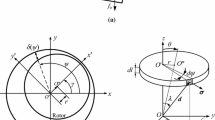Abstract
For winding configurations with parallel paths, synchronous electric motors can exhibit large amplitude rotor oscillations, which cannot be related to any rotation order nor investigated with classical harmonic analysis. This unusual behaviour is critical, since it can cause the rotor to hit the stator. It is a direct consequence of the coupling of rotor displacement with the magnetic flux and current distribution. It depends not only on the winding configuration, but also on the various motor design parameters. In order to explain this phenomenon, a simple analytical motor model has been built, including the full coupling between mechanical and electrical equations, which reproduces the behaviour observed experimentally. Using non-dimensional expressions allows to extract the few design ratios characterising the system, whose influence is then explored by stability analysis, in order to set their stability domain. It becomes thus possible to determine which parameters' configuration would lead to an unstable behaviour.











Similar content being viewed by others
References
Boy F (2020) Modelling the rotordynamics of saturated electric machines due to unbalanced magnetic pull, Dissertation: Kassel Universität
Früchtenicht J, Jordan H, Seinsch H-O (1982) Exzentrizitätsfelder als Ursache von Laufinstabilitäten bei Asynchronmaschinen - Teil 1: elektromagnetische Federzahl und elektromagnetische Dämpfungskonstante [Fields of excentricity causing running instability in induction machines], Archiv für Elektrotechnik 65
Li X, Bourdon A, Rémond D, Kœchlin S, Prieto D (2021) Angular-based modeling of unbalanced magnetic pull for analyzing the dynamical behavior of a 3-phase induction motor. J Sound Vib 494
Xu X, Han Q, Chu F (2018) A general electromagnetic excitation model for electrical machines considering the magnetic saturation and rub impact. J Sound Vib 416
Boy F, Hetzler H (2018) A co-energy based approach to model the rotordynamics of electrical machines. In : Proceedings of the 10th international conference on rotor dynamics – IFToMM 63
Seydel R (2009) Practical bifurcation and stability analysis, Interdisciplinary applied mathematics. Springer
Pelletan L, Baguet S, Torkhani M, Jacquet-Richardet G (2013) A comparison of stability computational methods for periodic solution of nonlinear problems with application to rotordynamics. Nonlinear Dyn
Sundararajan P, Noah ST (1998) An algorithm for response and stability of large order non-linear systems - application to rotor systems. J Sound Vib 214(4)
Teschl G (2012) Ordinary differential equations and dynamical systems. American Mathematical Society
Acknowledgements
The authors would like to thank Prof. Didier Rémond and Sébastien Baguet from LaMCos in Lyon for the fruitful discussions on this research project and their helpful suggestions. They also thank Nidec Leroy Somer for the overall project support, and more specifically Mike McClelland, Dany Prieto, Jacques Saint-Michel, Darelle Onatchy, Ago Tchalim Pato, Nicolas Gluard and Stephane Dedieu who all took part in the industrial challenge of develop** the cantilever motor described in the introduction.
Author information
Authors and Affiliations
Contributions
All authors reviewed and approved the final manuscript.
Corresponding author
Ethics declarations
Conflict of interest
The authors have no competing interests to declare that are relevant to the content of this article.
Additional information
Publisher's Note
Springer Nature remains neutral with regard to jurisdictional claims in published maps and institutional affiliations.
Appendix
Appendix
The magnetomotive \({mmf}_{stator}\) force is uniquely defined along the stator bore as a periodic step function by the equations
each step corresponding to a slot i travelled by a total current \(N\cdot {\mathbf{I}}_{\mathbf{s} i}\) (Fig. 6). One verifies that the expression of the stator mmf given in Eq. (9) and Eq. (10) fulfils both equations:
where the ns x ns matrix Nmmf is:
from \({\mathbf{N}}_{\mathbf{m}\mathbf{m}\mathbf{f}}\) definition above it follows:
Rights and permissions
Springer Nature or its licensor (e.g. a society or other partner) holds exclusive rights to this article under a publishing agreement with the author(s) or other rightsholder(s); author self-archiving of the accepted manuscript version of this article is solely governed by the terms of such publishing agreement and applicable law.
About this article
Cite this article
Kœchlin, S., Bourdon, A. Rotor instability due to electromechanical interactions in synchronous machines. Electr Eng 105, 2409–2420 (2023). https://doi.org/10.1007/s00202-023-01774-x
Received:
Accepted:
Published:
Issue Date:
DOI: https://doi.org/10.1007/s00202-023-01774-x




